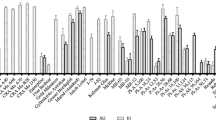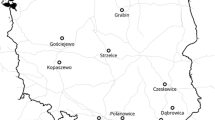Abstract
Pseudomonas syringae pv. aesculi (Pae) causes bleeding canker, a destructive disease of horse chestnut trees (Aesculus hippocastanum) that limits the breeding of horse chestnut genotypes. The susceptibility of 322 F1 progeny from 20 horse chestnut parent tree sources to the pathogen Pae was evaluated using different inoculation methods. The resulting infection rates, in decreasing order, were caused by inoculation of apical buds, inoculation of annual stems, insertion of bacteria into cut wounds on trunks and foliar spraying of the pathogen. According to the resistance index (RI) results of the field pathogenicity tests, at 2 or 3 years after inoculation 40, 40 and 20 % of horse chestnut parent tree sources were resistant, tolerant and susceptible, respectively, to Pae. Microbiological analyses of plant tissues from buds, phloem in the main trunks and roots of infected F1 progeny regardless of parent tree source showed long-term survival of Pae bacteria in 70 % of tolerant F1 progeny plants that lacked bleeding canker symptoms. Initial RI results and microbial analyses indicated that there was some frequency of resistance in the natural horse chestnut population. Altogether, 41 F1 progeny were the most promising lines based on their viability and the absence of Pae in their tissues.



Similar content being viewed by others

Abbreviations
- Pae :
-
Pseudomonas syringae pv. aesculi
- RI :
-
Resistance index
References
AESCULAP (2008). Eindrapport Onderzoeksprogramma “Behoud de kastanje” Deel 2 http://www.kastanjeziekte.wur.nl, Praktijkomderzoek Plant & Omgeving, Wageningen: Werkgroep Aesculaap, Boskoop, 96 pp.
Bardoux, S. & Rousseau, P. (2007). Le dépérissement bactérien du marronnier. Phytoma – La Défense des Végétaux no. 605, 22–23.
Dijkshoorn-Dekker, M. W. C. (2005). Eindrapport onderzoeksprogramma “Red de kastanje voor Nederland”. Praktijkomderzoek Plant & Omgeving, Wageningen: Werkgroep Aesculaap, Boskoop, 48 pp.
Durgapal, J. C., & Singh, B. (1980). Taxonomy of pseudomonads pathogenic to horsechestnut, wild fig and wild cherry in India. Indian Phytopathology, 33, 533–535.
EPPO reporting service, 2011/034.
Green, S., Laue, B., Fossdal, C. G., A’hara, S. W., & Cottrell, J. E. (2009). Infection of horse chestnut (Aesculus hippocastanum) by Pseudomonas syringae pv. aesculi and its detection by quantitative real-time PCR. Plant Pathology, 58, 731–744.
Green, S., Studholme, D., Laue, B., Dorati, F., Lovell, H., Arnold, D., Cottrell, J., Bridgett, S., Blaxter, M., Huitema, E., Thwaites, R., Sharp, P., Jackson, R., & Kamoun, S. (2010). Comparative genome analysis provides insights into the evolution and adaptation of Pseudomonas syringae pv. aesculi on Aesculus hippocastanum. PLoS ONE, 5(4), e10224. doi:10.1371/journal.pone.0010224.
Hattingh, M. J., Roos, I. M. M., & Mansvelt, E. L. (1989). Infection and systemic invasion of deciduous fruit trees by Pseudomonas syringae in South Africa. Plant Disease, 73(10), 784–789.
Kaminski, K., Wagner, S. & Werres, S. (2007). Neuartige Krankheit an Rosskastanien. Stadt + Grun, 56, 55–57.
Kennelly, M. M., Cazorla, F. M., de Vicente, A., Ramos, C., & Sundin, G. W. (2007). Pseudomonas syringae diseases of fruit trees. Progress towards understanding and control. Plant Disease, 91, 4–16.
King, E. O., Ward, M. K., & Raney, D. E. (1954). Two simple media for the demonstration of pyocyanin and fluorescin. Journal of Laboratory and Clinical Medicine, 44, 301–307.
Kleitman, F., Barash, I., Burger, A., Iraki, N., Falah, Y., Sessa, G., Weinthal, D., Chalupowicz, L., Gartemann, K. H., Eichenlaub, R., & Manulis-Sasson, S. (2008). Characterization of a Clavibacter michiganensis subsp. michiganensis population in Israel. European Journal of Plant Pathology, 121, 463–475. doi:10.1007/s10658-007-9264-z.
Koch, K. A., Quiramb, G. L., Venettec, R. C. (2010). A review of oak wiltmanagement: a summary of treatment options and their efficacy. UrbanForestry Urban Greening, 9, 1–8. doi: 10.1016/j.ufug.2009.11.004
Meletzus, D., Bermpohl, A., Dreier, J., & Eichenlaub, R. (1993). Evidence for plasmid-encoded virulence factors in the phytopathogenic bacterium Clavibacter michiganensis subsp. michiganensis NCPPB382. Journal of Bacteriology, 175, 2131–2136.
Mertelik, J., Kloudova, K., Pankova, I., Krejzar, V., & Kudela, V. (2013). Occurrence of horse chestnut bleeding canker caused by Pseudomonas syringae pv. aesculi in the Czech Republic. Forest Pathology, 43, 165–167.
Oleksyn, J., Kloeppel, B. D., Łukasiewicz, S., Karolewski, P., & Reich, P. B. (2007). Ecophysiology of horse chestnut (Aesculus hippocastanum L.) in degraded and restored urban sites. Polish Journal of Ecology, 55(2), 245–260.
Pankova, I., Krejzar, V., Mertelik, J. & Kloudova, K. (2013). Metodika inokulace jírovce mad’alu (Aesculus hipocastanum) původcem choroby bleeding canker, bakterií Pseudomonas syringae pv. aesculi v polních podmínkách. Certifikovaná metodika č.j. SRS 060412/2013,ISBN 978-80-7427-142-7.
Perez-Martinez, I., Zhao, Y., Murillo, J., Sundin, G. W., & Ramos, C. (2008). Global genomic analysis of Pseudomonas savastanoi plasmids. Journal of Bacteriology, 190, 625–635.
Ploetz, R. C. & Gregory, N. (1992). Mango malformation in Florida: distribution of Fusarium subglutinans in affected trees, and relationships among strains within and among different orchards. IV International Mango Symposium, pp. 341.
Schmidt, O., Dujesiefken, D., Stobbe, H., Moreth, U., Kehr, R., & Schroder, T. (2008). Pseudomonas syringae pv. aesculi associated with horse chestnut bleeding canker in Germany. Forest Pathology, 38(2), 124–128.
Steele, H., Laue, B. E., Mc Askill, G. A., Hendry, S. J., & Green, S. (2010). Analysis of the natural infection of European horse chestnut (Aesculus hippocastanum) by Pseudomonas syringae pv. aesculi. Plant Pathology, 59, 1005–1013.
Thomidis, T., & Exadaktylou, E. (2008). Susceptibility of 30 cherry (Prunus avium) genotypes to the bacterium Pseudomonas syringae pv. syringae. New Zealand Journal of Crop and Horticulture Science, 36, 215–220.
Úradníček, L., Maděra, P., Tichá, S., Koblížek, J., 2010. Woody plants of the Czech Republic. eds. Lesnická práce, Kostelec nad Černými lesy, pp. 368.
Vanneste, J. L., & Voyle, M. D. (2003). Genetic basis of copper resistance in New Zealand strains of Pseudomonas syringae. New Zealand Plant Protection, 56, 109–112.
Webber, J. F., Parkinson, N. M., Rose, R., Stanford, H., Cook, R. T. A., & Elphinstone, J. G. (2008). Isolation and identification of Pseudomonas syringae pv. aesculi causing bleeding canker of horse chestnut in the UK. Plant Pathology, 57, 368.
Acknowledgments
This work was supported by the Czech National Agency for Agricultural Research (NAZV), project QI92A246.
Author information
Authors and Affiliations
Corresponding author
Rights and permissions
About this article
Cite this article
Pánková, I., Krejzar, V., Mertelík, J. et al. The occurrence of lines tolerant to the causal agent of bleeding canker, Pseudomonas syringae pv. aesculi, in a natural horse chestnut population in Central Europe. Eur J Plant Pathol 142, 37–47 (2015). https://doi.org/10.1007/s10658-014-0587-2
Accepted:
Published:
Issue Date:
DOI: https://doi.org/10.1007/s10658-014-0587-2



